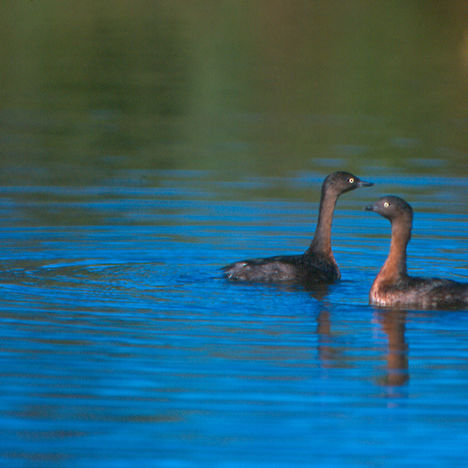Other names:
Weweia, totokipio, taihoropi (Hokianga), taratimoho (Waikato), New Zealand grebeThreat category:
At Risk: Recovering?Regions:
Northland, Auckland, Waikato, Bay of Plenty, Gisborne, Hawkes Bay, Manawatu-Wanganui, Taranaki, WellingtonDistribution:
North Island, rare observations in South Island
Description
- The New Zealand dabchick is only found in New Zealand.
- It is a small grebe, about a quarter of the weight of the southern crested grebe. It can be distinguished from the Australasian little grebe by the lack of a distinctive brown cap and the lack of a yellow patch of skin between the eye and bill.
Interesting Facts
- The dabchick is widespread in the North Island on lakes, dams and oxidation ponds.
- The population is estimated at 1,900-2,000 birds.
- The species used to be found on South Island lakes, but the last breeding records were from the 1940s. However, a pair began breeding near Takaka in 2012, and another near Blenheim in 2015.
- New Zealand dabchicks need clear-water lakes and ponds surrounded by dense riparian cover.
- The reasons for decline and the extirpation of the South Island population are not well understood. A combination of introduced predators, loss of habitat, increased disturbance and declining water quality are thought to be the primary threats.
- All wetland birds require high quality wetland habitat buffered from the effects of surrounding land management.
Association with Plantations
- Wetland birds are found in or adjacent to many plantation forests.
- Wetland birds may be hard to detect due to their elusive behaviour.
Threats
- Habitat loss and degradation from wetland drainage, loss of riparian margins, and the effects of surrounding landuse.
- Invasion of exotic plants, which can seriously modify wetlands and reduce suitability for birds.
- Disturbance and motor wash from recreational boats
- High predation rates, particularly of pateke, mainly from dogs, cats and mustelids.
- Mammalian predation may also affect some other wetland bird species, but the extent of the impacts is largely unknown.
Management Options and Methods
- Habitat protection:
- Protect important wetland habitats and riparian buffers.
- Avoid using herbicides or pesticides close to wetlands.
- Ensure weeds are not inadvertently introduced to wetlands, e.g. via machinery or boats.
- Consider control options for existing, invasive, wetland weeds.
- Consider a staged removal of willows to ensure ongoing cover for crakes and ducks.
- Forest operations:
- Minimise damage to riparian and wetland habitat during road construction and harvest operations.
- Avoid grazing wetlands and their margins. Fencing may be appropriate in some situations.
- Avoid diverting run-off into wetlands.
- Minimise disturbance during spring breeding.
- If pateke are present, discuss predator control with neighbours and DOC.
- Injured or dead wetland birds (particularly the more threatened species, i.e. white heron, bittern and pateke):
- Place injured birds in a cardboard box (keep shaded) and deliver to a local vet, SPCA, DOC.
- Call DOC if bird is dead.
Monitoring Options
- Increase staff and contractor knowledge about wetland birds.
- For important wetlands that are likely to have the more threatened species, consider undertaking a bird monitoring programme:
- Counts of pateke flock sites in late summer.
- Fernbirds, spotless crakes and to a lesser extent marsh crakes and banded rails respond to taped playback calls.
- The booming calls of bittern are characteristic at dusk in September-October particularly during bright moonlight.
- Maintain a database of sightings.
Further Information and Support
- New Zealand Birds Online: New Zealand dabchick.
- Department of Conservation website: New Zealand dabchick.
- Wetland Restoration: A Handbook for New Zealand Freshwater Systems. Landcare Research - Manaaki Whenua.
- Pest management - Department of Conservation, Regional Councils.



